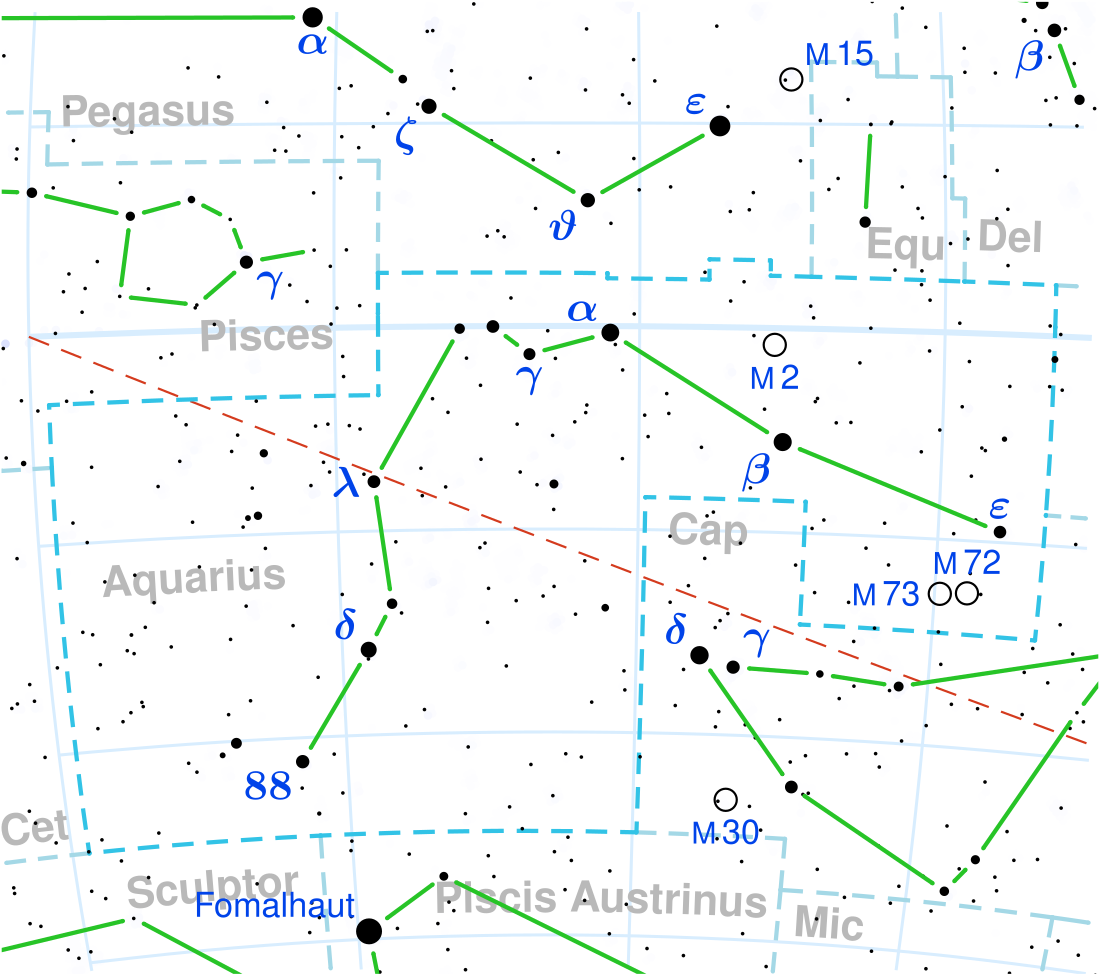Alpha Aquarii
Star in the constellation Aquarius From Wikipedia, the free encyclopedia
Alpha Aquarii is a yellow supergiant star in the constellation of Aquarius. Its identifier is a Bayer designation that is Latinized from α Aquarii, and is abbreviated Alf Aqr or α Aqr, respectively. This star has the official name Sadalmelik, pronounced /ˌsædəlˈmɛlɪk/.[15] At an apparent visual magnitude of 2.94,[2] it is the second-brightest star in Aquarius, just marginally fainter than Beta Aquarii. Based upon parallax measurements made by the Gaia spacecraft, it is located at a distance of roughly 690 light-years (210 parsecs).[5] It is drifting further away from the Sun with a radial velocity of 7.5 km/s.[4]
Nomenclature
Summarize
Perspective
α Aquarii (Latinised to Alpha Aquarii) is the star's Bayer designation. WDS J22058-0019 A is its designation in the Washington Double Star Catalog.
It bore the traditional name Sadalmelik, which derived from an Arabic expression سعد الملك (sa‘d al-malik), meaning "Luck of the king" or “arm/support of God”. The name Rucbah had also been applied to this star; though it shared that name with Delta Cassiopeiae.[14] It is only one of two stars with ancient proper names to lie within a degree of the celestial equator. The origin of the Arabic name is lost to history.[16] In 2016, the International Astronomical Union organized a Working Group on Star Names (WGSN)[17] to catalogue and standardize proper names for stars. The WGSN approved the name Sadalmelik for Alpha Aquarii (WDS J22058-0019 A) on 21 August 2016, and it is now so included in the List of IAU-approved Star Names (Delta Cassiopeiae was given the name Ruchbah).[15]
In Chinese, 危宿 (Wēi Xiù), meaning Rooftop (asterism), refers to an asterism consisting of Alpha Aquarii, Theta Pegasi and Epsilon Pegasi.[18] Consequently, the Chinese name for Alpha Aquarii itself is 危宿一 (Wēi Xiù yī, English: the First Star of Rooftop).[19]
Properties
Summarize
Perspective
With an age of 53 million years,[3] Alpha Aquarii has evolved into a supergiant with a stellar classification of G2 Ib.[3] It lies within the Cepheid instability strip of the Hertzsprung–Russell diagram, near the red (cooler) edge, but is not classified as a variable star. However, variable cores have been detected in the hydrogen lines, which are originating in a circumstellar envelope.[9] The star has a massive stellar wind that reaches supersonic velocity in the chromosphere.[20]
There is some uncertainty about Alpha Aquarii's distance. The original Hipparcos catalog gave a parallax of 4.3±0.83 mas, which translates to a distance of 233±45 parsecs, or 760 light-years.[21] However, the 2007 Hipparcos reduction give a parallax that implies a distance of 161±5 pc, or 520 light-years.[22] The third Gaia data release (Gaia DR3) give a parallax of 4.94±0.43 mas, translating to a distance of 202±17 pc, or 660 light-years.[1]
Alpha Aquarii's angular diameter has been measured at 3.066±0.036 mas.[23] This diameter, at its estimated distance,[5] translates to a radius of 70 times the radius of the Sun.[8] With insufficient mass to explode as a supernova, it will most likely become a massive white dwarf similar to Sirius B.[16] It is radiating 3,900 times as much luminosity as the Sun from its outer atmosphere[7] at an effective temperature of 5,190 K.[9] At this heat, the star glows with the yellow hue of a G-type star.[24] Examination of this star with the Chandra X-ray Observatory shows it to be significantly X-ray deficient compared to G-type main-sequence stars. This deficit is a common feature of early G-type giant stars.[10]
Alpha Aquarii has a visual companion, UCAC2 31789179, of magnitude 12.2. It is at an angular separation of 110.4 arcseconds from Alpha Aquarii along a position angle of 40°.[13] However, the pair is only a visual double, with UCAC2 31789179 being a background star.[25]
References
External links
Wikiwand - on
Seamless Wikipedia browsing. On steroids.

